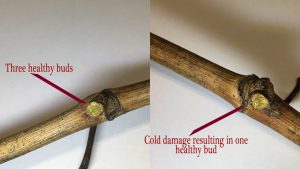A brief background of winter pruning wine grape vines (Vitis vinifera)
The primary practice of vineyard management is to achieve a maximum yield (see definitions below), at the desired quality. One of the greatest influences on both yield and quality is winter pruning. Winter pruning involves the selective removal of up to 90% of the previous season’s vine growth. The overall goal of winter pruning is to prepare the vines for the upcoming growing season. This pruning helps to construct the location and general development of the canopy. A properly constructed canopy has great influence on overall grape yield, health, and development.
As the name would suggest, this highly influential pruning is normally conducted during the winter months, while the vines are dormant. In the Fall, the vines begin moving complex minerals and nutrients via the vascular system from the leaves, down into the permanent wood (roots, trunk, cordons). Pruning too early in the season can disrupt this nutrient transfer, leaving the vines deficient for the upcoming growing season. Pruning too late can sometimes lead to a delayed bud-break, which in turn can affect the entire growing season. Also, pruning while the vines are dormant and absent of foliage allows for easier wood selection and cane tying.

The first round of winter pruning at Riverbend Vineyard removes the majority of the cane (the previous season’s growth) to allow for a more precise bud selection at the final pruning pass.
Pruning removes buds, via cane removal, that would otherwise become new shoots and bear fruit the following season. By removing buds, growth is concentrated into the remaining buds, and eventually, canopy and fruit development. Before winter pruning, a single vine can have well over 100 buds. On average, a single vine is pruned down to 30-36 buds per vine. Pruning either too much or too little can lead to an unbalanced vine and grape development. Pruning the vines too much means more buds were removed than necessary and the growth from those remaining buds might not provide enough nutrients and minerals to fully ripen the fruit. Also, during dormancy, precious nutrients and minerals are stored in all woody parts of the vines, and the more woody material removed, the fewer nutrients and minerals available for the upcoming growing season. Not pruning the vines enough means too many buds were left on the spurs, which will result in an excess of vegetative growth, leading to uneven fruit development.

Cabernet Sauvignon vines pruned to 3 buds per spur at our Estate Riverbend Vineyard.
Fielding Hills Winery utilizes a trellising system for its vineyards called Bi-lateral Cordon – Vertical Shoot Position (VSP). This means that from one rooting system there are two trunks that are trained vertically (side-by-side) from the ground up to the cordon wire on the trellis system. At the trellis wire, each cordon branches off at a 90-degree angle in an opposite direction along the wire. Each cordon has on average 5-6 spurs (10-12 spurs per vine), and each spur is pruned to a desired bud count. From each bud emerges a shoot, which is then trained vertically from the cordon. These shoots mature into hard and woody (lignified) canes and eventually bear fruit.

All pruning at Riverbend Vineyard is done by hand.
Selecting how many buds to leave per spur depends on many different factors. Usually, the younger a vine the fewer buds left per spur. As the vine matures, more buds are left per spur until vine and grape development are at an achieved balanced state. Depending on where in the world the vines are grown, climate and soil fertility influence vine vigor and growth, which in turn can be controlled by bud selection. Grape varietal greatly influences bud count determination. At our Estate Riverbend Vineyard, on average, Syrah vines are pruned to 28 buds per vine; whereas, Cabernet Franc vines can be pruned to 40 buds per vine. It’s also important to understand that bud count selection is not a set number or formula from one year to the next. If vines sustain cold damage over the winter, more buds may need to be left per spur to achieve proper vine and grape development.

Cross section of a healthy Syrah compound-bud, possessing three viable immature buds (primary, secondary, and tertiary). Cross section of cold damaged Syrah compound-bud showing dead primary and secondary bud, but a viable tertiary bud.
Winter pruning should be seen as just the first step in a growing season towards achieving vine balance and optimum grape development. When properly pruned, shoot vigor can be controlled permitting the vine to fully ripen its fruit to the desired yield. Equally important to consistently ripening fruit from one year to the next is the overall long-term health of the vines at our Estate Riverbend Vineyard. It is this consistent fruit that provides Fielding Hills Winery with the essential foundation on which we produce our wines.
Definitions
- Buds – One or more embryonic shoots protected in a series of modified leaves called bud scales.
- Bud Break – When buds begin to swell and grow.
- Cane – The vine shoot from the period it matures and lignifies (turns brown and woody) until the end of the second year of growth.
- Canopy – The foliage cover of the vine.
- Compound-bud – The mature axillary bud that survives the winter; typically possessing three immature buds in differing states of development.
- Cordon – An arm or trunk extension positioned horizontally or at an angle to the axis of the trunk.
- Spur – A short cane possessing the desired bud count.
- Trunk – The vertical wood stem of a vine up to the origin of the branches.
- Vitis vinifera – The primary grape species cultivated and used as a source of wine, table grapes, and raisin grapes.
- Yield – The fruit crop per area planted.
Sources:
Jackson, R.S. (2008) Wine Science: Principles and Applications. London: Academic.
